Exploring Primary Care's Role in Health Care Delivery and Transitions
VerifiedAdded on 2023/04/25
|7
|1529
|397
Essay
AI Summary
This essay discusses the crucial role of primary care in providing accessible healthcare, managing resources, and facilitating patient transitions within the healthcare system. It highlights that primary care addresses a significant portion of patient needs through curative, preventive, and promotive care. The primary healthcare delivery system serves as the initial point of contact, offering patient-centered care and coordinating with other levels of care when specialized services are required. It also plays a vital role in managing human, financial, and physical resources to improve patient care and address community health issues. Furthermore, primary care facilitates the transition of patients to secondary care by providing medical histories and relevant information. Strengthening the infrastructure of primary healthcare services is essential for resolving health issues within the community. Access more solved assignments and resources on Desklib.
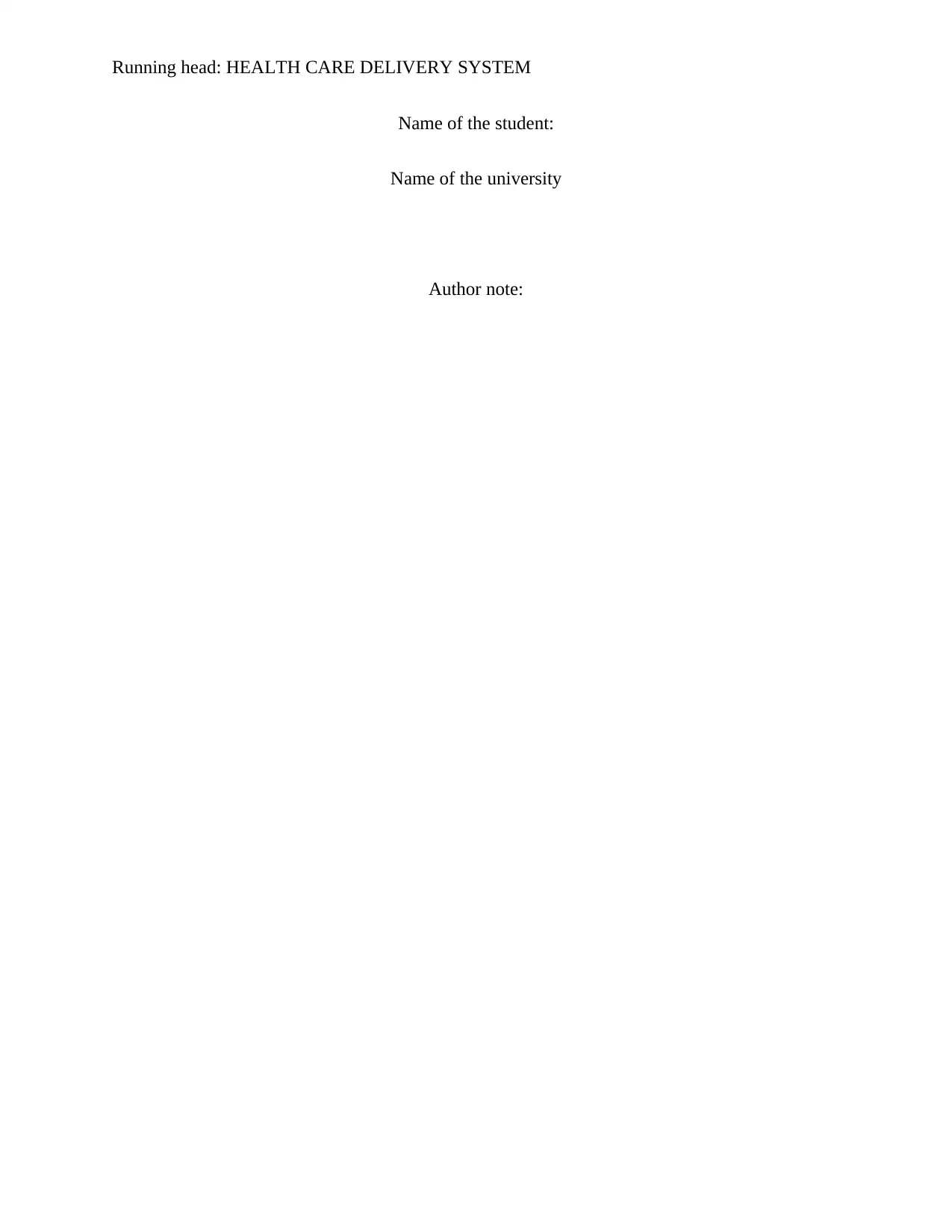
Running head: HEALTH CARE DELIVERY SYSTEM
Name of the student:
Name of the university
Author note:
Name of the student:
Name of the university
Author note:
Paraphrase This Document
Need a fresh take? Get an instant paraphrase of this document with our AI Paraphraser
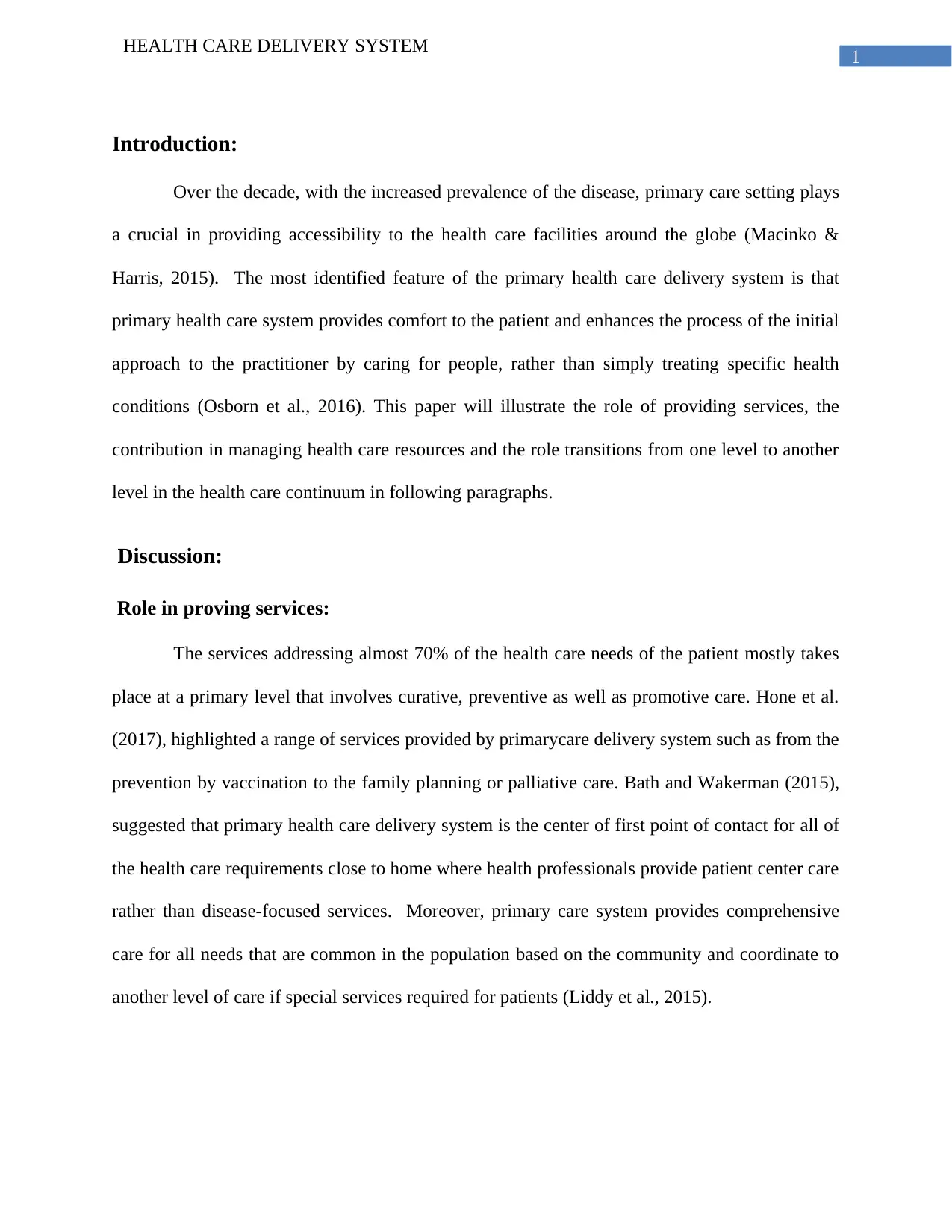
1
HEALTH CARE DELIVERY SYSTEM
Introduction:
Over the decade, with the increased prevalence of the disease, primary care setting plays
a crucial in providing accessibility to the health care facilities around the globe (Macinko &
Harris, 2015). The most identified feature of the primary health care delivery system is that
primary health care system provides comfort to the patient and enhances the process of the initial
approach to the practitioner by caring for people, rather than simply treating specific health
conditions (Osborn et al., 2016). This paper will illustrate the role of providing services, the
contribution in managing health care resources and the role transitions from one level to another
level in the health care continuum in following paragraphs.
Discussion:
Role in proving services:
The services addressing almost 70% of the health care needs of the patient mostly takes
place at a primary level that involves curative, preventive as well as promotive care. Hone et al.
(2017), highlighted a range of services provided by primarycare delivery system such as from the
prevention by vaccination to the family planning or palliative care. Bath and Wakerman (2015),
suggested that primary health care delivery system is the center of first point of contact for all of
the health care requirements close to home where health professionals provide patient center care
rather than disease-focused services. Moreover, primary care system provides comprehensive
care for all needs that are common in the population based on the community and coordinate to
another level of care if special services required for patients (Liddy et al., 2015).
HEALTH CARE DELIVERY SYSTEM
Introduction:
Over the decade, with the increased prevalence of the disease, primary care setting plays
a crucial in providing accessibility to the health care facilities around the globe (Macinko &
Harris, 2015). The most identified feature of the primary health care delivery system is that
primary health care system provides comfort to the patient and enhances the process of the initial
approach to the practitioner by caring for people, rather than simply treating specific health
conditions (Osborn et al., 2016). This paper will illustrate the role of providing services, the
contribution in managing health care resources and the role transitions from one level to another
level in the health care continuum in following paragraphs.
Discussion:
Role in proving services:
The services addressing almost 70% of the health care needs of the patient mostly takes
place at a primary level that involves curative, preventive as well as promotive care. Hone et al.
(2017), highlighted a range of services provided by primarycare delivery system such as from the
prevention by vaccination to the family planning or palliative care. Bath and Wakerman (2015),
suggested that primary health care delivery system is the center of first point of contact for all of
the health care requirements close to home where health professionals provide patient center care
rather than disease-focused services. Moreover, primary care system provides comprehensive
care for all needs that are common in the population based on the community and coordinate to
another level of care if special services required for patients (Liddy et al., 2015).

2
HEALTH CARE DELIVERY SYSTEM
The contribution of the primary care in managing health care resources:
As an initial source of the health services, primary health care delivery system plays a
crucial role in managing the health care resources. In terms of human resources, primary health
care delivery system addresses the patient needs in the community and identifies the common
health issues within the community and contributes to the recruitment in the health professionals
(Smolowitz et al., 2015). For example, in a community with an increasing number of older
individuals, palliative care as well as residential care is required. The primary health care
delivery system incorporates the suggestions to recruit the skilled health professionals for the
residential care as well as aged care. Moreover, in terms of the financial resources, primary
health care system evaluates the ways of proving better patient centric care to the community
members and coordinates for policy making or special funding from other organizations to focus
on the needs of the patients rather than treating the patient (Freund et al., 2015). For example, in
a community where equity of care required for different socio-demographic background, primary
health care delivery system contributes to the policy-making in order to provide all facilities to
each group in the community. In terms of physical resources such as diagnosis equipment’s or
educational tools, primary health care delivery system coordinates with the administrative
managers to bring specific tools or equipment (Dietz et al., 2015). For example, in a community
with inadequate knowledge of managing the symptoms of depression, primary health care
delivery system collaborates with the higher authority for bringing the projector to educate
patients.
HEALTH CARE DELIVERY SYSTEM
The contribution of the primary care in managing health care resources:
As an initial source of the health services, primary health care delivery system plays a
crucial role in managing the health care resources. In terms of human resources, primary health
care delivery system addresses the patient needs in the community and identifies the common
health issues within the community and contributes to the recruitment in the health professionals
(Smolowitz et al., 2015). For example, in a community with an increasing number of older
individuals, palliative care as well as residential care is required. The primary health care
delivery system incorporates the suggestions to recruit the skilled health professionals for the
residential care as well as aged care. Moreover, in terms of the financial resources, primary
health care system evaluates the ways of proving better patient centric care to the community
members and coordinates for policy making or special funding from other organizations to focus
on the needs of the patients rather than treating the patient (Freund et al., 2015). For example, in
a community where equity of care required for different socio-demographic background, primary
health care delivery system contributes to the policy-making in order to provide all facilities to
each group in the community. In terms of physical resources such as diagnosis equipment’s or
educational tools, primary health care delivery system coordinates with the administrative
managers to bring specific tools or equipment (Dietz et al., 2015). For example, in a community
with inadequate knowledge of managing the symptoms of depression, primary health care
delivery system collaborates with the higher authority for bringing the projector to educate
patients.
⊘ This is a preview!⊘
Do you want full access?
Subscribe today to unlock all pages.

Trusted by 1+ million students worldwide
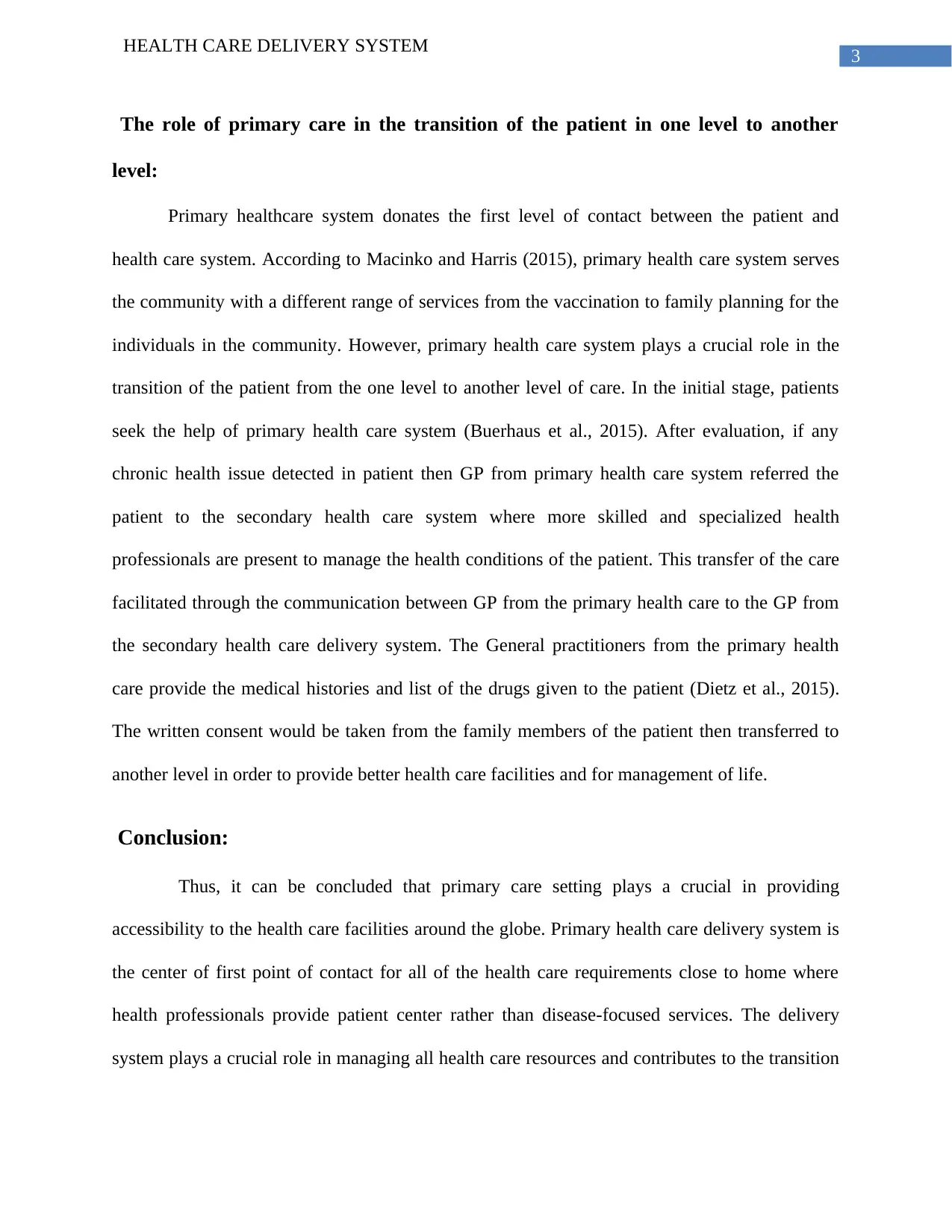
3
HEALTH CARE DELIVERY SYSTEM
The role of primary care in the transition of the patient in one level to another
level:
Primary healthcare system donates the first level of contact between the patient and
health care system. According to Macinko and Harris (2015), primary health care system serves
the community with a different range of services from the vaccination to family planning for the
individuals in the community. However, primary health care system plays a crucial role in the
transition of the patient from the one level to another level of care. In the initial stage, patients
seek the help of primary health care system (Buerhaus et al., 2015). After evaluation, if any
chronic health issue detected in patient then GP from primary health care system referred the
patient to the secondary health care system where more skilled and specialized health
professionals are present to manage the health conditions of the patient. This transfer of the care
facilitated through the communication between GP from the primary health care to the GP from
the secondary health care delivery system. The General practitioners from the primary health
care provide the medical histories and list of the drugs given to the patient (Dietz et al., 2015).
The written consent would be taken from the family members of the patient then transferred to
another level in order to provide better health care facilities and for management of life.
Conclusion:
Thus, it can be concluded that primary care setting plays a crucial in providing
accessibility to the health care facilities around the globe. Primary health care delivery system is
the center of first point of contact for all of the health care requirements close to home where
health professionals provide patient center rather than disease-focused services. The delivery
system plays a crucial role in managing all health care resources and contributes to the transition
HEALTH CARE DELIVERY SYSTEM
The role of primary care in the transition of the patient in one level to another
level:
Primary healthcare system donates the first level of contact between the patient and
health care system. According to Macinko and Harris (2015), primary health care system serves
the community with a different range of services from the vaccination to family planning for the
individuals in the community. However, primary health care system plays a crucial role in the
transition of the patient from the one level to another level of care. In the initial stage, patients
seek the help of primary health care system (Buerhaus et al., 2015). After evaluation, if any
chronic health issue detected in patient then GP from primary health care system referred the
patient to the secondary health care system where more skilled and specialized health
professionals are present to manage the health conditions of the patient. This transfer of the care
facilitated through the communication between GP from the primary health care to the GP from
the secondary health care delivery system. The General practitioners from the primary health
care provide the medical histories and list of the drugs given to the patient (Dietz et al., 2015).
The written consent would be taken from the family members of the patient then transferred to
another level in order to provide better health care facilities and for management of life.
Conclusion:
Thus, it can be concluded that primary care setting plays a crucial in providing
accessibility to the health care facilities around the globe. Primary health care delivery system is
the center of first point of contact for all of the health care requirements close to home where
health professionals provide patient center rather than disease-focused services. The delivery
system plays a crucial role in managing all health care resources and contributes to the transition
Paraphrase This Document
Need a fresh take? Get an instant paraphrase of this document with our AI Paraphraser
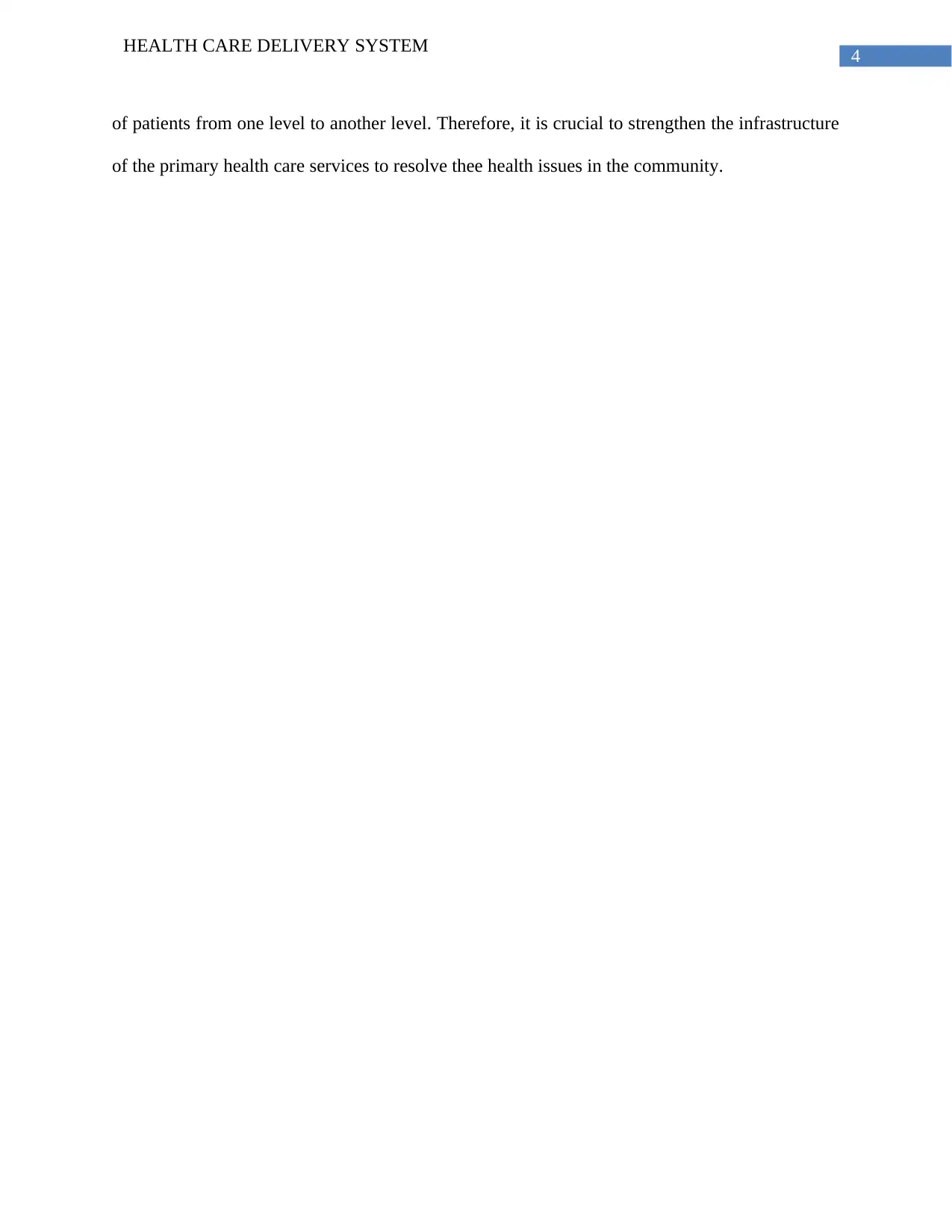
4
HEALTH CARE DELIVERY SYSTEM
of patients from one level to another level. Therefore, it is crucial to strengthen the infrastructure
of the primary health care services to resolve thee health issues in the community.
HEALTH CARE DELIVERY SYSTEM
of patients from one level to another level. Therefore, it is crucial to strengthen the infrastructure
of the primary health care services to resolve thee health issues in the community.
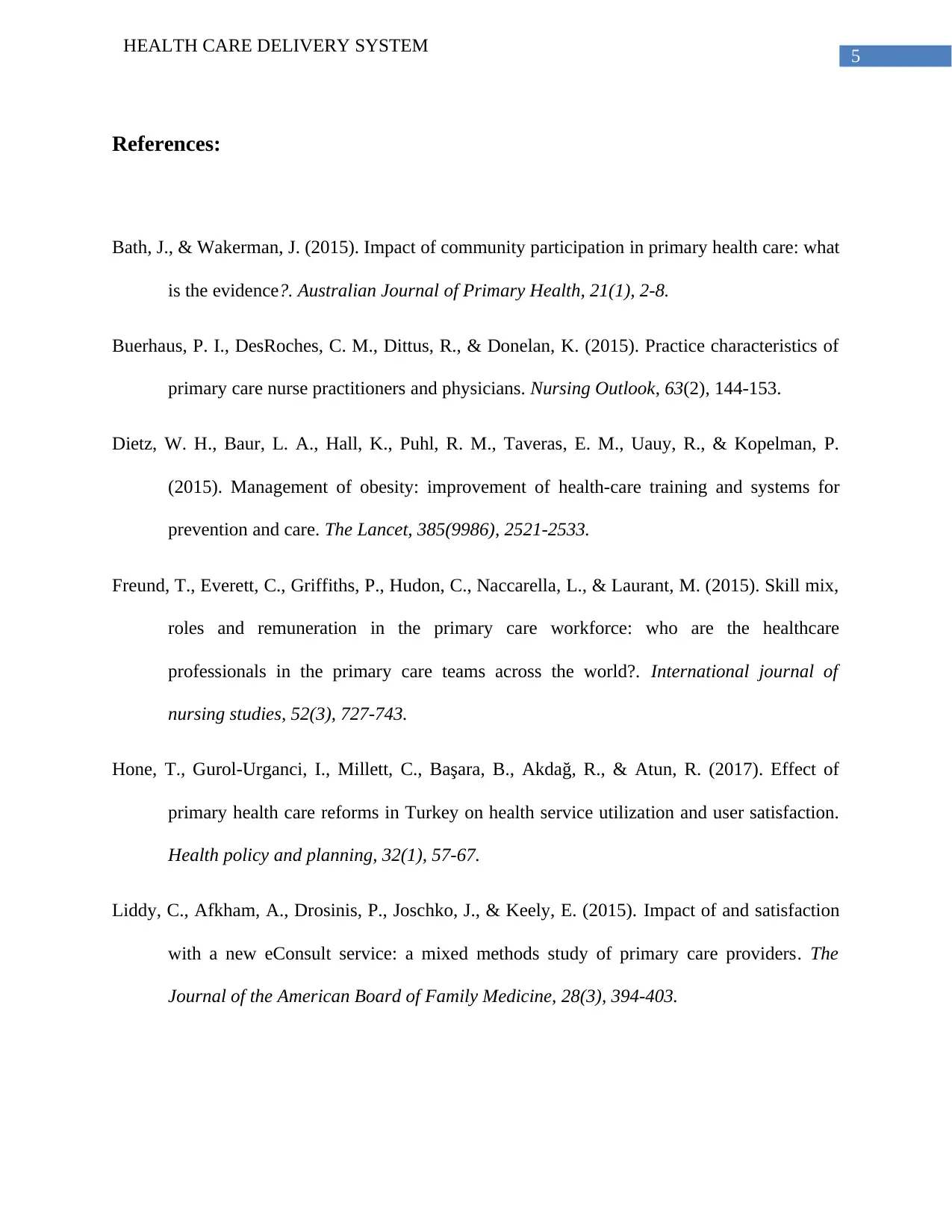
5
HEALTH CARE DELIVERY SYSTEM
References:
Bath, J., & Wakerman, J. (2015). Impact of community participation in primary health care: what
is the evidence?. Australian Journal of Primary Health, 21(1), 2-8.
Buerhaus, P. I., DesRoches, C. M., Dittus, R., & Donelan, K. (2015). Practice characteristics of
primary care nurse practitioners and physicians. Nursing Outlook, 63(2), 144-153.
Dietz, W. H., Baur, L. A., Hall, K., Puhl, R. M., Taveras, E. M., Uauy, R., & Kopelman, P.
(2015). Management of obesity: improvement of health-care training and systems for
prevention and care. The Lancet, 385(9986), 2521-2533.
Freund, T., Everett, C., Griffiths, P., Hudon, C., Naccarella, L., & Laurant, M. (2015). Skill mix,
roles and remuneration in the primary care workforce: who are the healthcare
professionals in the primary care teams across the world?. International journal of
nursing studies, 52(3), 727-743.
Hone, T., Gurol-Urganci, I., Millett, C., Başara, B., Akdağ, R., & Atun, R. (2017). Effect of
primary health care reforms in Turkey on health service utilization and user satisfaction.
Health policy and planning, 32(1), 57-67.
Liddy, C., Afkham, A., Drosinis, P., Joschko, J., & Keely, E. (2015). Impact of and satisfaction
with a new eConsult service: a mixed methods study of primary care providers. The
Journal of the American Board of Family Medicine, 28(3), 394-403.
HEALTH CARE DELIVERY SYSTEM
References:
Bath, J., & Wakerman, J. (2015). Impact of community participation in primary health care: what
is the evidence?. Australian Journal of Primary Health, 21(1), 2-8.
Buerhaus, P. I., DesRoches, C. M., Dittus, R., & Donelan, K. (2015). Practice characteristics of
primary care nurse practitioners and physicians. Nursing Outlook, 63(2), 144-153.
Dietz, W. H., Baur, L. A., Hall, K., Puhl, R. M., Taveras, E. M., Uauy, R., & Kopelman, P.
(2015). Management of obesity: improvement of health-care training and systems for
prevention and care. The Lancet, 385(9986), 2521-2533.
Freund, T., Everett, C., Griffiths, P., Hudon, C., Naccarella, L., & Laurant, M. (2015). Skill mix,
roles and remuneration in the primary care workforce: who are the healthcare
professionals in the primary care teams across the world?. International journal of
nursing studies, 52(3), 727-743.
Hone, T., Gurol-Urganci, I., Millett, C., Başara, B., Akdağ, R., & Atun, R. (2017). Effect of
primary health care reforms in Turkey on health service utilization and user satisfaction.
Health policy and planning, 32(1), 57-67.
Liddy, C., Afkham, A., Drosinis, P., Joschko, J., & Keely, E. (2015). Impact of and satisfaction
with a new eConsult service: a mixed methods study of primary care providers. The
Journal of the American Board of Family Medicine, 28(3), 394-403.
⊘ This is a preview!⊘
Do you want full access?
Subscribe today to unlock all pages.

Trusted by 1+ million students worldwide
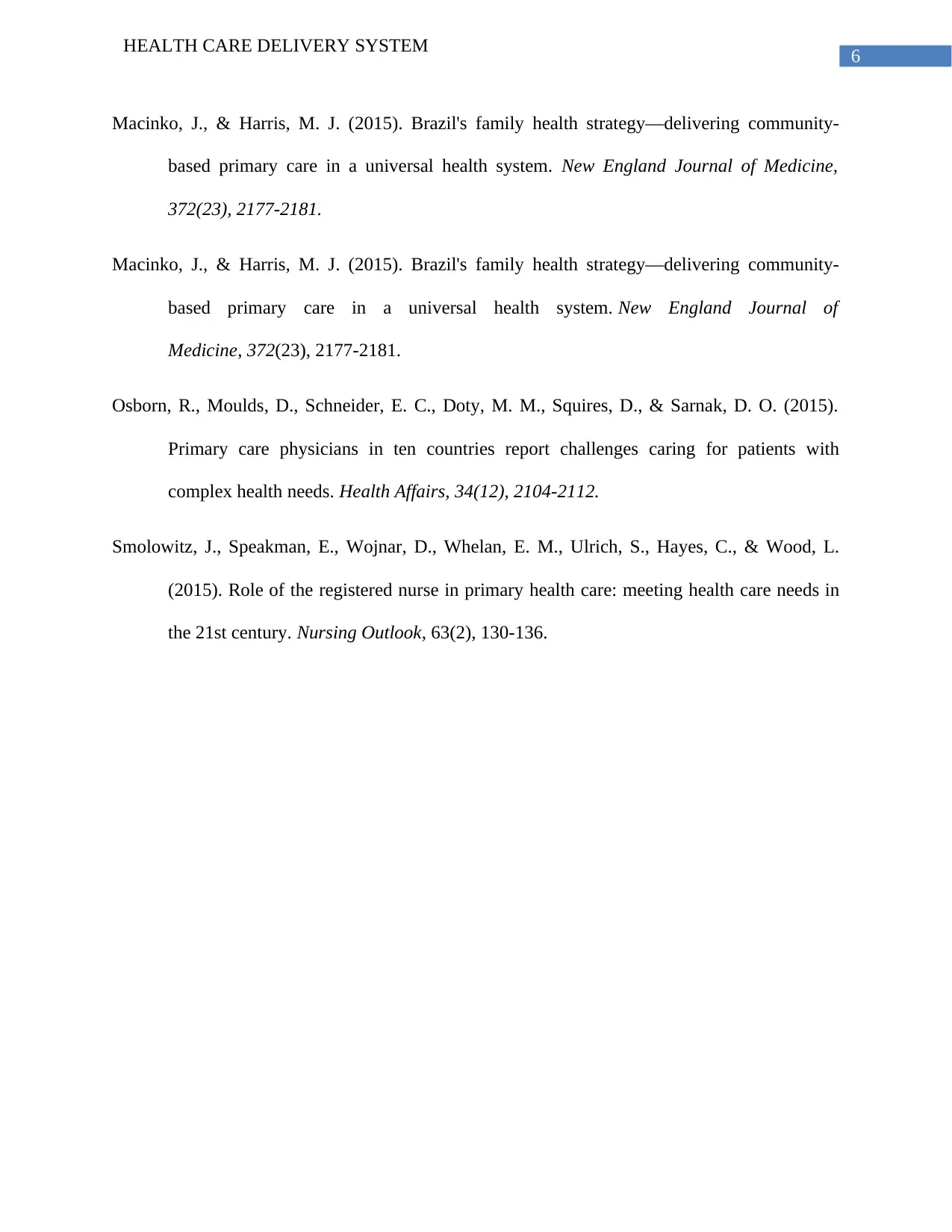
6
HEALTH CARE DELIVERY SYSTEM
Macinko, J., & Harris, M. J. (2015). Brazil's family health strategy—delivering community-
based primary care in a universal health system. New England Journal of Medicine,
372(23), 2177-2181.
Macinko, J., & Harris, M. J. (2015). Brazil's family health strategy—delivering community-
based primary care in a universal health system. New England Journal of
Medicine, 372(23), 2177-2181.
Osborn, R., Moulds, D., Schneider, E. C., Doty, M. M., Squires, D., & Sarnak, D. O. (2015).
Primary care physicians in ten countries report challenges caring for patients with
complex health needs. Health Affairs, 34(12), 2104-2112.
Smolowitz, J., Speakman, E., Wojnar, D., Whelan, E. M., Ulrich, S., Hayes, C., & Wood, L.
(2015). Role of the registered nurse in primary health care: meeting health care needs in
the 21st century. Nursing Outlook, 63(2), 130-136.
HEALTH CARE DELIVERY SYSTEM
Macinko, J., & Harris, M. J. (2015). Brazil's family health strategy—delivering community-
based primary care in a universal health system. New England Journal of Medicine,
372(23), 2177-2181.
Macinko, J., & Harris, M. J. (2015). Brazil's family health strategy—delivering community-
based primary care in a universal health system. New England Journal of
Medicine, 372(23), 2177-2181.
Osborn, R., Moulds, D., Schneider, E. C., Doty, M. M., Squires, D., & Sarnak, D. O. (2015).
Primary care physicians in ten countries report challenges caring for patients with
complex health needs. Health Affairs, 34(12), 2104-2112.
Smolowitz, J., Speakman, E., Wojnar, D., Whelan, E. M., Ulrich, S., Hayes, C., & Wood, L.
(2015). Role of the registered nurse in primary health care: meeting health care needs in
the 21st century. Nursing Outlook, 63(2), 130-136.
1 out of 7
Related Documents
Your All-in-One AI-Powered Toolkit for Academic Success.
+13062052269
info@desklib.com
Available 24*7 on WhatsApp / Email
![[object Object]](/_next/static/media/star-bottom.7253800d.svg)
Unlock your academic potential
Copyright © 2020–2025 A2Z Services. All Rights Reserved. Developed and managed by ZUCOL.





